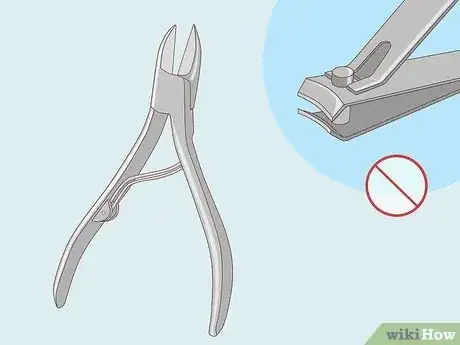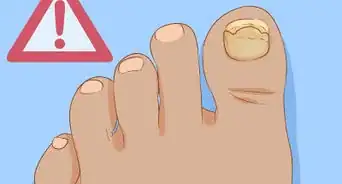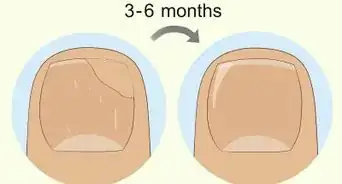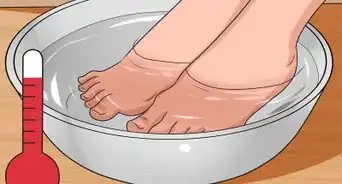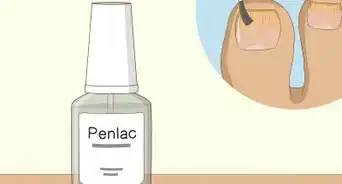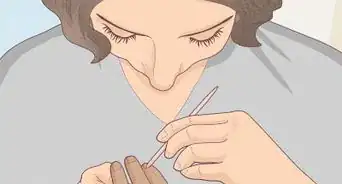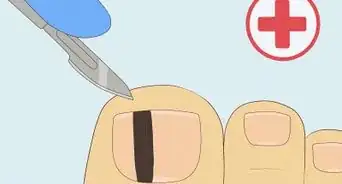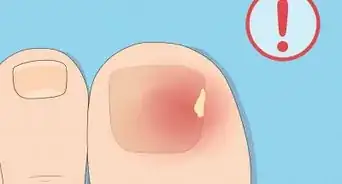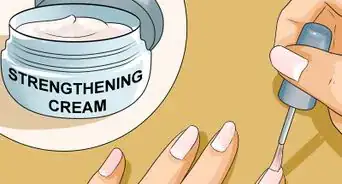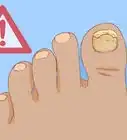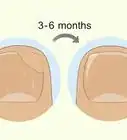This article was co-authored by Marta Nagorska and by wikiHow staff writer, Hunter Rising. Marta Nagorska is a Nail Technician and Nail Art Blogger based in London, UK. She runs the blog, Furious Filer, where she gives tutorials on nail care and advanced nail art. She has been practicing nail art for over 5 years and graduated from Northampton College with distinction with a Nail Technician and Manicurist degree in 2017. She has been awarded the top spot in the OPI Nail Art Competition.
There are 14 references cited in this article, which can be found at the bottom of the page.
This article has been viewed 106,484 times.
When you’re dealing with nail fungus, your toenails can thicken up and make them a little trickier to trim. We know you don’t want to damage your nails or spread the fungus, and fortunately, you can still make your nails look great with the right tools and techniques. Keep reading to learn how to soften and trim your nails and how to prevent the fungus from spreading.
Things You Should Know
- Soak your nails in warm water for 10 minutes to soften them before trimming. Alternatively, apply a urea cream to your nails to soften them.
- Make small cuts straight across your nails with a pair of nail nippers to stop the nails from breaking.
- File down sharp edges with a nail file or emery board to prevent your nails from catching on anything.
- Visit a doctor if trimming your toenails causes pain or if you aren’t able to cut through them on your own.
Steps
Softening & Thinning Thick Toenails
-
1Soak your nails in warm water for about 10 minutes. Fill a tub or large bowl with warm water and dip your toes in so they’re submerged. The heat and moisture will help soften your toenails so they’re less likely to break when you trim them. After about 10 minutes, dry your nails off so you can start cutting them.[1]
- Alternatively, trim your nails as soon as you get out of the shower since they’ll already be softened.
- If you have really thick toenails from fungus, then try soaking your nails for up to 30 minutes so the moisture can penetrate deeper.
- Try adding in 1 teaspoon (6 g) of salt for every 1 US pint (470 ml) of water you use for your foot soak if your nails are difficult to cut. The salt will help soften your nails so they’re easier to cut through.[2]
-
2Try softening and scraping nails with urea cream and a file. Urea cream penetrates deeper into your nail and softens the surface. Rub a fingertip-sized amount of the cream onto your nails and cover them with a bandage. You can leave the cream on your nail for up to 24 hours to soften your nail. After that, rub the surface lightly with your nail file to scrape away some of the fungus.[3]
- You may need to apply the urea cream nightly for a few days until your nails become soft.
- Avoid applying too much pressure when you’re filing the surface of your nail. If you feel any pain, stop filing right away.
Advertisement -
3Thin extremely thick nails with an electric file. An electric file has a rotating abrasive head that grinds down the surface of your nail so it’s thinner and easier to cut. Soak or soften your nails beforehand so they’re easier to grind. Turn the electric file on and gently rub the spinning head over your toenails. Apply light pressure as you use your file to remove up to half of the toenail’s thickness.[4]
- If your nail starts feeling hot or if you feel any pain, stop using your electric file right away since you could break through the nail.
Cutting Fungal Toenails
-
1Use nail nippers meant for cutting toenails. Your nails may be too thick to easily cut with regular clippers, so use a pair of nippers instead. Nail nippers look similar to a pair of scissors and they have a stronger blade that makes it easier to cut through toenails with fungus.[5]
- Avoid using nail clippers that are small and made for cutting fingernails since they won’t be able to fully cut through your nail.
- Fungus is contagious, so don't share your nail nippers with anyone else.[6]
-
2Clip straight across your nails using short, small cuts. Start at the outer corner of your nail and make short, horizontal cuts across the top. Trim your toenails just shorter than the ends of your toes. Rather than rounding the corners of your nails, keep them straight to avoid getting an ingrown nail.[7]
- Make your cut through the white part at the end of your nail so you don’t accidentally cut into your nail bed.
-
3File your nails with a file or emery board. Once you’re done trimming toenails with fungus, gently rub the file or emery board against the edges of your nails. Rather than moving the file back and forth along the edge, only file in one direction to prevent your nail from cracking or fraying. Once the edge feels smooth, you can stop filing your toenail.[8]
- Filing your nails will prevent them from snagging on your socks, which could cause further irritation or injury.
-
4Trim your nails every 6–8 weeks. Toenails only grow about 2 millimetres (0.079 in) every month, so they don’t need to be cut as frequently as your fingernails.[9] Once your nails start sticking out past the ends of your toes, trim them so they’re less likely to catch on anything.
Preventing the Spread of Nail Fungus
-
1Cut toenails with fungus after healthy nails. Nippers contaminated with nail fungus can spread the infection to any healthy nails you still have.[10] Focus on the nails that don’t have any signs of fungus before you move on to clipping the ones that are thick or hardened.
- Use a separate pair of clippers for your fingernails so you can avoid any cross-contamination with toenail fungus.
-
2Sanitize your nippers with rubbing alcohol before and after each use. After trimming thick toenails with fungus, rinse the nippers with soapy water. Then, wet a cloth with rubbing alcohol and wipe your nippers down to get rid of any bacteria. Since bacteria could get on your nippers in between uses, clean them before the next time you use them too.[11]
- Alternatively, you can use a disinfectant like Barbicide made specifically for killing fungus on beauty and nail care tools.
-
3Throw away any wood or cardboard files you used. Fungus can spread through the dust that comes off your nails and sticks to disposable files. Rather than reusing them, toss them in the trash and get new tools for the next time you trim your nails.[12]
- If you use a file made of metal or glass, you can disinfect it with rubbing alcohol and use it again.
-
4Visit your doctor to remove and treat fungus as soon as you can. It can be a little tricky to fully treat toe fungus on your own, so talk to your doctor as soon as you notice changes in your nail’s appearance. Your doctor will be able to prescribe you oral or topical medication that will get rid of the fungus so your nail looks healthy again.[13]
- If your toenails are too thick to cut on your own or if it hurts when you try trimming them, then your doctor will be able to trim them for you.
- You can try using over-the-counter nail fungus remover, but it might not get rid of all of the fungus.
- If you have swelling or pain around your toenails or if you have trouble walking, see your doctor immediately.[14]
Expert Q&A
-
QuestionWhat if I have trouble cutting my toenails?
 Marta NagorskaMarta Nagorska is a Nail Technician and Nail Art Blogger based in London, UK. She runs the blog, Furious Filer, where she gives tutorials on nail care and advanced nail art. She has been practicing nail art for over 5 years and graduated from Northampton College with distinction with a Nail Technician and Manicurist degree in 2017. She has been awarded the top spot in the OPI Nail Art Competition.
Marta NagorskaMarta Nagorska is a Nail Technician and Nail Art Blogger based in London, UK. She runs the blog, Furious Filer, where she gives tutorials on nail care and advanced nail art. She has been practicing nail art for over 5 years and graduated from Northampton College with distinction with a Nail Technician and Manicurist degree in 2017. She has been awarded the top spot in the OPI Nail Art Competition.
Nail Artist If you have fungus, your toenail will most likely be discolored, thick, and brittle, which makes it difficult to cut. If you're having trouble, talk to a professional, like a podiatrist, to help provide treatment and care.
If you have fungus, your toenail will most likely be discolored, thick, and brittle, which makes it difficult to cut. If you're having trouble, talk to a professional, like a podiatrist, to help provide treatment and care.
Warnings
- Avoid cutting or pushing back your cuticles when you trim your nails since they help protect you from any further nail infections.[16]⧼thumbs_response⧽
- Nail fungus could spread to the skin between your toes, your groin, or your scalp. Wash your hands after you trim your nails to keep the fungus under control.[17]⧼thumbs_response⧽
Things You’ll Need
References
- ↑ https://my.clevelandclinic.org/health/diseases/11303-toenail-fungus
- ↑ https://www.aad.org/public/everyday-care/nail-care-secrets/basics/healthy-nail-tips
- ↑ https://www.ncbi.nlm.nih.gov/books/NBK279546/
- ↑ https://youtu.be/HYc2kRXrUJs?t=139
- ↑ https://youtu.be/GaQFUun0MU4?t=29
- ↑ Marta Nagorska. Nail Artist. Expert Interview. 26 May 2021.
- ↑ https://youtu.be/6xHfag8nMms?t=259
- ↑ https://www.aad.org/public/everyday-care/nail-care-secrets/basics/how-to-trim-nails
- ↑ https://onlinelibrary.wiley.com/doi/10.1111/j.1468-3083.2009.03426.x
- ↑ https://www.aad.org/public/diseases/a-z/prevent-another-nail-infection
- ↑ https://www.aad.org/public/diseases/a-z/prevent-another-nail-infection
- ↑ https://www.ncbi.nlm.nih.gov/pmc/articles/PMC3937521/
- ↑ https://my.clevelandclinic.org/health/diseases/11303-toenail-fungus
- ↑ https://www.mayoclinic.org/diseases-conditions/nail-fungus/symptoms-causes/syc-20353294
- ↑ https://www.nhs.uk/conditions/fungal-nail-infection/
- ↑ https://www.aad.org/public/everyday-care/nail-care-secrets/basics/how-to-trim-nails
- ↑ https://my.clevelandclinic.org/health/diseases/11303-toenail-fungus



